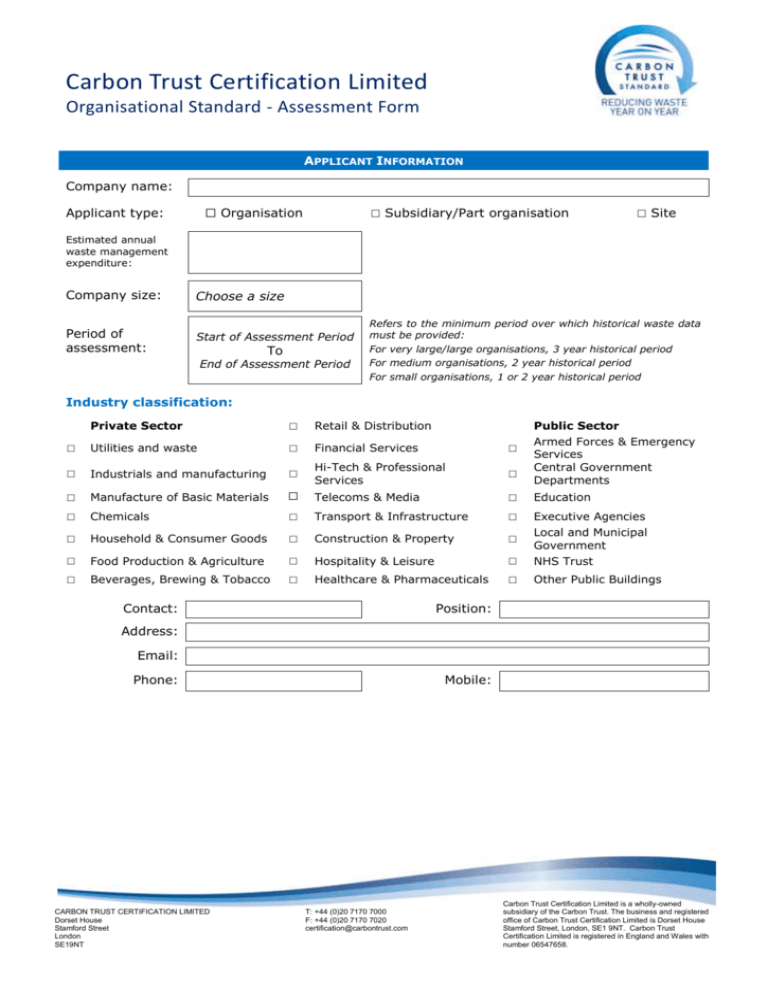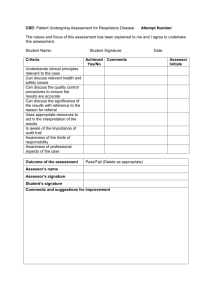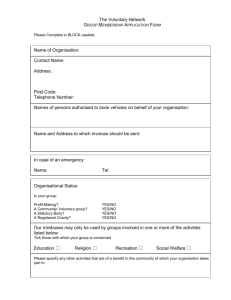
Carbon Trust Certification Limited
Organisational Standard - Assessment Form
APPLICANT INFORMATION
Company name:
☐ Subsidiary/Part organisation
☐ Organisation
Applicant type:
☐ Site
Estimated annual
waste management
expenditure:
Company size:
Choose a size
Period of
assessment:
Start of Assessment Period
To
End of Assessment Period
Refers to the minimum period over which historical waste data
must be provided:
For very large/large organisations, 3 year historical period
For medium organisations, 2 year historical period
For small organisations, 1 or 2 year historical period
Industry classification:
Private Sector
☐
Retail & Distribution
☐
Utilities and waste
☐
Financial Services
☐
☐
Industrials and manufacturing
☐
Hi-Tech & Professional
Services
☐
☐
Manufacture of Basic Materials
☐
Telecoms & Media
☐
Education
☐
Chemicals
☐
Transport & Infrastructure
☐
☐
Household & Consumer Goods
☐
Construction & Property
☐
☐
Food Production & Agriculture
☐
Hospitality & Leisure
☐
Executive Agencies
Local and Municipal
Government
NHS Trust
☐
Beverages, Brewing & Tobacco
☐
Healthcare & Pharmaceuticals
☐
Other Public Buildings
Contact:
Public Sector
Armed Forces & Emergency
Services
Central Government
Departments
Position:
Address:
Email:
Phone:
CARBON TRUST CERTIFICATION LIMITED
Dorset House
Stamford Street
London
SE19NT
Mobile:
T: +44 (0)20 7170 7000
F: +44 (0)20 7170 7020
certification@carbontrust.com
Carbon Trust Certification Limited is a wholly-owned
subsidiary of the Carbon Trust. The business and registered
office of Carbon Trust Certification Limited is Dorset House
Stamford Street, London, SE1 9NT. Carbon Trust
Certification Limited is registered in England and Wales with
number 06547658.
WASTE MEASUREMENT
Calculation of waste arisings should follow the principles and requirements outlined in the
Corporate Waste Protocol. All waste arisings should be reported in tonnes.
Organisational boundary: This is used to define which parts of an organisation are included
in the waste arisings measurement and includes selecting an approach for inclusion of waste
arisings from joint venture and subsidiaries
Description of organisational boundary:
(See agreed proposal for assessment)
How are joint-owned or controlled assets
accounted for:
Click here to enter text.
Choose an item.
Specific facilities/divisions included in
boundary: e.g. 150 retail stores across UK plus
London HQ (please mark UK and overseas facilities)
Exclusions:
Waste arisings which were excluded (de minimis): each must be less than 1% of the total
waste arisings and must total no more than 5% of the total waste arisings
Estimated % of
Reason for exclusion and explanation
Waste arisings
total waste
of calculation
arisings
1.
%
2.
%
3.
%
Benchmarks: Waste arisings can be compared year on year on an absolute basis (measured in
tonnes) or using a relative benchmark (e.g. tonnes of waste/tonne product, tonnes of waste/£m
turnover, etc.
If a relative benchmark is to be used
please specify the denominator:
e.g. tonne product, £m turnover
Rationale for benchmark:
Assessor: Has the applicant measured
waste arisings accurately, and according to
The Corporate Waste Protocol? If not,
please explain the deficiencies in the data.
Carbon Trust Waste Standard Assessment Form v1_0
P
A
WASTE REDUCTION
To enable a like-for-like comparison, the reduction rules must apply to the same organisational
boundary (i.e. adjusted to take into account any acquisitions or divestments). The applicant may
choose to use an absolute or relative basis for comparison in accordance with The Corporate
Waste Protocol.
Choose an item.
Reduction assessment based on:
Identify any structural changes in the organisation which have resulted in adjustment of the
waste arisings figures to enable like-for-like comparisons (e.g., outsourcing, divestments or
acquisitions):
Please note: adjustments should only be made for structural changes (e.g. buying or selling of part of a business) and
not for organic changes (e.g. closing of an office)
Waste
arisings
(tonnes)
Structural change:
e.g. Divestment of division X
June 2007
100
Adjustment made:
Waste arisings of division X excluded from
calculations using the ‘adjustment’ tab of the
calculator
1.
2.
3.
Adjusted figures used for reduction criteria - please enter information from ‘Summary of Results’
sheet in the Waste Spreadsheet
Base Year(s)
Reduction Type
Historical data
Pass / Fail
data
Absolute waste arisings
(tonnes)
Choose an item.
Relative benchmark
Choose an item.
e.g. tonnes of waste/tonne
product
Turnover benchmark
Choose an item.
e.g. tonnes of waste/£mn
Please list the top 3 waste reduction initiatives/actions taken during the period of assessment,
along with estimated impact:
Initiative:
When?
Estimated annual
waste reduction
(tonnes)
1.
2.
3.
Assessor: Has the applicant achieved an
absolute or relative reduction according to
The Corporate Waste Protocol?
Carbon Trust Waste Standard Assessment Form v1_0
P
A
WASTE MANAGEMENT
For each of the questions below please provide a brief self-explanatory
description in the box provided, referencing any relevant documents.
The key documents (e.g. waste policy, extract of annual report, copy of
communications material) should be referenced and attached as evidence.
Other documents referred to should be provided to the Assessor during the site
visit if requested.
We recommend no more than 20 additional pages should be attached; please
only attach relevant sections of documents.
The example evidence provided with each question is not exhaustive and only
relevant elements should be submitted.
Where appropriate, achievement of other certification can be used as evidence
e.g., ISO14001.
Assessment will be made taking into consideration the size and circumstance of
the organization.
Please discuss these questions with your assessor to decide the most
appropriate piece of evidence.
To be completed by assessor: please provide any relevant context for the moderator e.g.,
organisation description, previous certification.
Section I: GOVERNANCE
1. Policy: Does the organisation have a waste policy?
Does it set organisational boundary? Does it have clear waste objectives? Does it
prioritise waste prevention, continual improvement and the application of the waste
hierarchy? Does it assign responsibilities effectively, and have appropriate methods of
communicating its provisions to staff? Is it reviewed and updated regularly?
Please provide a copy of your waste policy. This may be part of a wider environmental
policy and should evidence clear objectives and an action plan. Please clarify who has
signed it off (e.g. management, Board, union representatives, etc.) and if it is available
on any internal or external websites.
Assessor comments and justification of score:
What could be done better?
Evidence document(s) name, page no.:
Mark
(out of 5)
0
Carbon Trust Waste Standard Assessment Form v1_0
P
A
2. Responsibility: Which Board Committee
responsibility for matters relating to waste?
or
other
executive
body
has
overall
How often is waste performance reviewed by senior management? What is the day-to-day
management structure? Example evidence may include relevant organisational charts; minutes
from relevant board meetings; number of FTEs with responsibility for waste management (% of
time).
Response:
Assessor comments and justification of score:
What could be done better?
Mark
(out of 5)
0
Evidence document(s) name, page no.:
3. Communication: How is waste management performance communicated to relevant
stakeholders?
Are organisational boundaries used? Does organisation communicate total waste generated;
waste split according to type and subtype; financial metrics; explanation of any significant
exclusions or recalculations; and reduction goals and progress? Example evidence may include
Annual/CSR Report; website printouts; reporting to parent organisation.
Response:
Assessor comments and justification of score:
What could be done better?
Evidence document(s) name, page no.:
Mark
(out of 5)
0
Section II: WASTE ACCOUNTING
4. Monitoring, measuring and reporting: Does the organisation ensure that waste arisings
data, and related operations are measured and documented for waste destined for reuse,
recycling, energy recovery, landfill and incineration without energy recovery?
Does the organisation conduct routine waste stream reviews (including determining which
wastes may be moved up the hierarchy) and update the reviews annually? Are these procedures
documented and verifiable? Example evidence may include recorded measurements of waste
arisings prior to leaving the site; EDOCS; waste transfer notes; weigh bills; and invoices.
Response:
Assessor comments and justification of score:
Mark (out of 10)
What could be done better?
Evidence document(s) name, page no.:
0
Carbon Trust Waste Standard Assessment Form v1_0
P
A
5. Waste hierarchy: Does the organization understand the concept of the waste hierarchy?
Does it take all necessary measures to apply the waste hierarchy within the defined
boundaries? Does the organisation ensure that all waste handlers in the disposition chain also
apply the waste hierarchy?
Do operations prioritise waste reduction? When waste cannot be reduced, does the organisation
apply the hierarchy in priority sequence both in-house and when waste is transferred? Does the
organisation have evidence to demonstrate that all waste transferred is dealt with in a priority
sequence as required by the hierarchy? Does the organisation declare compliance with the
hierarchy on its waste transfer notes?
Response:
Assessor comments and justification of score:
What could be done better?
Mark
(out of 10)
0
Evidence document(s) name, page no.:
Section III: MANAGEMENT
6. Targets: Does the organisation have waste reduction and waste hierarchy target(s)?
Are these targets challenging and quantifiable? Are they measured against a baseline year?
Example evidence may include documentation of target(s).
Response:
Assessor comments and justification of score:
What could be done better?
Evidence document(s) name, page no.:
Mark
(out of 5)
0
7. Training and competence: Are there awareness programmes for all staff and appropriate
training for those with responsibility for waste management? Are staff sufficiently competent
to carry out their obligations?
Is there regular internal or external training for those with waste management responsibilities?
Do these programmes engage all staff in reducing waste? Evidence may include communication
material; e-mails; articles; contents page of training material; external training courses attended
or certification achieved; calculated man-days of training time.
Response:
Carbon Trust Waste Standard Assessment Form v1_0
P
A
Assessor comments and justification of score:
What could be done better?
Mark
(out of 5)
0
Evidence document(s) name, page no.:
8. Waste minimisation programmes and investments: What programmes exist to minimise
waste and implement the waste hierarchy across the defined boundaries? What capital
investments to reduce waste have been made over the last 4 years? What plans are there for
further investment?
What programmes or quality control mechanisms does the organisation have in place to ensure
that the operating procedures and practices of all sites and equipment minimise waste? Please
provide documentation of key actions taken to minimise waste, e.g. reduction of waste at source,
increased recycling rates, new operating instructions, maintenance changes, operating
instructions/terms of reference, and documentation of current and planned investments.
Response:
Assessor comments and justification of score:
What could be done better?
Mark
(out of 15)
0
Evidence document(s) name, page no.:
9. Upstream impacts: Does the organisation consider the impacts of its supply chain?
Does the organisation have a detailed and enforced procurement policy which specifies
preference for products/materials that are less waste intensive and divertible when no longer
useful? E.g. does the organisation consider the recyclability, recycled content, reusability, etc. of
procured goods? Does this procurement policy prioritise the waste hierarchy? Does the
organisation consider the waste management policies/credentials of organisations from which
services are procured? Does the organisation collaborate with supply chain to reduce waste?
Evidence may include a copy of the procurement policy; evidence of past and current purchases
for comparison and evaluation; emails and other communication documents.
Response:
Assessor comments and justification of score:
What could be done better?
Evidence document(s) name, page no.:
Mark
(out of 5)
0
Carbon Trust Waste Standard Assessment Form v1_0
P
A
10. Downstream impacts: Does the organisation consider the downstream impacts of its
products and services?
Does the organisation have a detailed and enforced policy which deals with the downstream
considerations of products/packaging and/or services? Are there programmes in place that
reduce the lifecycle waste impact of organisation’s products/packaging and/or services? E.g.
product take-back initiatives, packaging optimisation, redesigned products to reduce raw
materials, toxicity, and to increase durability, and recyclability? Does the organisation
demonstrate that their products and packaging have conformed to other standards? Example
evidence may include a copy of the policy; documents about initiatives and products that seek to
minimise lifecycle waste.
Response:
Assessor comments and justification of score:
What could be done better?
Mark
(out of 5)
0
Evidence document(s) name, page no.:
11. Waste management services: Has the organisation exercised its duty of care obligations?
Has it ensured that its waste contractors carry out their duty in a responsible manner? Has
the organisation conducted sufficient due diligence for its procured waste management
services?
Does the organisation produce evidence of each hauling and handling service for all waste
streams? Does the organisation specifiy preference for waste contractors that handle waste in a
hierarchical manner? Evidence may include EDOCS or paper records; waste transfer notes; email communications inquiring about material handling and disposal.
Response:
Assessor comments and justification of score:
What could be done better?
Mark
(out of 5)
0
Evidence document(s) name, page no.:
12.Leadership and other initiatives (Bonus): Has the organisation developed and
implemented any other measure(s) that demonstrate leadership and/or innovation?
Do these initiative demonstrate sector leadership, best practice and innovation?
Assessor comments and justification of score:
What could be done better?
Evidence document(s) name, page no.:
Mark
(out of 5)
0
Carbon Trust Waste Standard Assessment Form v1_0
P
A
Section IV: SITE VISIT (To be completed by the assessor)
13. Site visit: Based on the site visits, does the organisation display good overall waste
management practices? For recertification, has the organisation responded appropriately to
previous recommendations?
Assessor comments and justification of score:
What could be done better?
Mark
(out of 10)
0
Summary of Qualitative Scores
**Instructions for use: once the form is complete and all the scores are filled out in the tables
above, please right click on each score in the table below and select ‘Update Field’. Don’t forget
to also update the field of the Total – this must be done after all the individual scores have been
updated as it is a ‘sum’ function of the scores in this summary table.
Section I:
Governance
Section II: Waste
accounting
Section III:
Management
Section IV: Site Visit
Policy
Responsibility
Communication
Monitoring, measuring and reporting
Waste hierarchy
Targets
Training and competence
Waste minimisation programmes and
investments
Upstream impacts
Downstream impacts
Waste management services
Leadership and other initiatives
Site Visit
0
0
0
0
0
0
0
0
0
0
0
0
Total qualitative mark (out of 90)
Note: score of 54/90 or 60% constitutes a pass
Assessor recommendation: Choose an item.
Assessor comments and justification of score:
Queries
If you have any questions about this form, please contact your assessor or email your query to
assessments@carbontrust.com.
© The Carbon Trust June 2008-2013. All rights reserved.
Any trademarks, servicemarks or logos used in this document are the property of the Carbon
Trust.
Carbon Trust Waste Standard Assessment Form v1_0
P
A
Nothing in this document shall be construed as granting any licence or right to use or reproduce
any of the trademarks, service marks, logos, copyright or any proprietary information in any
way without the Carbon Trust’s prior written permission.
The Carbon Trust enforces infringements of its intellectual property rights to the full extent
permitted by law.
Carbon Trust Waste Standard Assessment Form v1_0
P
A









